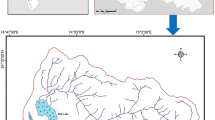Abstract
The water chemistry of Pichola lake revealed that it is dominated by Na and HCO3. The lake water chemistry strongly reflects the dominance of continental weathering aided by anthropogenic activity, such as tourist influx, developmental activities in the catchment area, and disposal of untreated municipal and domestic sewage into the lake basin. The supply of major ions is mainly through weathering of the silicate rock exposed in the drainage basin and the contribution from saline and alkaline soils/groundwater because of the semiarid conditions of the region. The increase in phosphate loading and consequent depletion of silica suggests biological consumption of the latter. The observed chemical data of Pichola lake was used to predict the mineral assemblages in the carbonate and aluminosilicate system. It demonstrates that calcite and dolomite are the possible minerals that are in equilibrium with the lake water system and that the lake water chemistry is in the range of stability of kaolinite.
Similar content being viewed by others
References
Banerjee DM (1987) Environmental impact of phosphate mining in India. J Geol Soc India 30:439–450
Banerjee DM and Bhattacharya P (1994) Petrology and geochemistry of greywackes from Aravalli Supergroup, Rajasthan, India and the tectonic evolution of a Proterozoic Sedimentary basin. Precambrian Res 67:11–35
Black CA (1957) Soil plant relationships. New York: Wiley & Sons, p 334
Burgis MJ and Morris P (1987) The natural history of Lakes. Cambridge: Cambridge University Press, p 218
Garreis RM and Christ CL (1965) Solutions, minerals and equilibria. New York: Harper and Row, 450 p
Gibbs RJ (1970) Mechanisms controlling world water chemistry. Science 170:1088–1090
Heron AM (1953) The geology of the central Rajasthan. Mem Geol Surv India 79:389 pp
Khan MA and Zutshi DP (1980) Contribution to the high altitude limnology of the Himalayan system. I Limnology and primary productivity of the plankton community of Nilnag Lake, Kashmir. Hydrobiologia 75:103–112
Kharaka YK, Robinson SW, Law LM, and Carothers WD (1984) Hydrogeochemistry of Big Soda Lake, Nevada: An alkaline meromictic desert lake. Geochim Cosmochim Acta 48:823–835
Rajasthan Pollution Prevention and Control Board (1986) Environmental status of lakes in Rajasthan. Environmental Status Document series on surface waters ESDS/SW/1/86-87, Jaipur
Ramanathan AL, Vaithiyanathan P, Subramanian V, and Das BK (1994) Nature and transport of solute load in the cauvery river basin, India Water Res 28(7):1585–1593
Roy AB (1988) Stratigraphic and tectonic framework of the Aravalli Mountain Range: Geol Soc India Mem 7:3–31
Ruttner F (1953) Fundamentals of limnology. Translated by DG Frey and FEJ Frey. Toronto: University Press, 242 pp
Sarin MM, Krishnaswamy S, Dilli K, Samayajulu BLK, and Moore WS (1989) Major ion chemistry of the Ganga-Brahmaputra river system: Weathering processes and fluxes to the Bay of Bengal. Geochim Cosmochim Acta 53(5):997–1010
Schelske CL (1988) Historic trends in Lake Michigan silica concentrations. Int Rev Gesamten Hydrobiol 73(5):559–591
Singh M (1994) Environmental geochemical study of pollution in lakes of Nainital District, Kumaun Himalaya, India. PhD thesis (unpublished), 261 pp
Visser SA and Villeneuve JP (1975) Similarities and differences in the chemical composition of waters from West, Central and East Africa. Verh Int Ver Theore Angew Limnol 19:1416–1426
Vyas LN (1968) Studies on phytoplankton ecology of Pichola lake, Udaipur. In: Misra R and Gopal B (Eds), Proceedings of the symposium of recent advances in tropical ecology; Part I. Varanasi: International Society of Tropical Ecology, pp 334–347
Wigley TML (1973) The incongruent dissolution of dolomite. Geochim Cosmochim Acta 37:1397–1402
Author information
Authors and Affiliations
Rights and permissions
About this article
Cite this article
Das, B.K., Singh, M. Water chemistry and control of weathering of Pichola Lake, Udaipur District, Rajasthan, India. Geo 27, 184–190 (1996). https://doi.org/10.1007/BF00770431
Received:
Accepted:
Issue Date:
DOI: https://doi.org/10.1007/BF00770431




